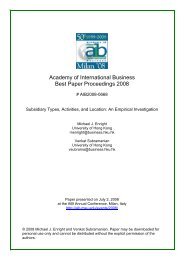AIB 2012 Conference Proceedings - Academy of International ...
AIB 2012 Conference Proceedings - Academy of International ...
AIB 2012 Conference Proceedings - Academy of International ...
You also want an ePaper? Increase the reach of your titles
YUMPU automatically turns print PDFs into web optimized ePapers that Google loves.
TUESDAY<br />
Natural disasters create damage not only to a country's people and infrastructure but also to their firm's assets.<br />
The aftermath <strong>of</strong> a disaster brings uncertainty and changes to markets near and far the epicenter <strong>of</strong> the event.<br />
We posit that firms will respond to this uncertainty via expanding their global footprint, in particular sales<br />
abroad. We test our hypothesis using a large sample <strong>of</strong> almost one hundred thousand firm year observations<br />
and more than two thousand five hundred natural disasters in fifty countries from 1990 – 2004. We find that<br />
disaster damage is positively correlated with foreign sales, furthermore we show that this effect is persistent<br />
over time. Even 3 years after a disaster firms continue to increase their level <strong>of</strong> foreign sales. More interestingly<br />
we show that this effect is more pronounce for smaller firms and those from poorer countries. (For more<br />
information, please contact: Andres Ramirez, Bryant University, USA: aramirez@bryant.edu)<br />
Model <strong>of</strong> Corporate Culture, Strategic Change and Corporate Performance: Evidence from the Chinese<br />
Construction Industry<br />
Mingming Liu, Dalian University <strong>of</strong> Technology<br />
Susan Freeman, University <strong>of</strong> Adelaide<br />
Md. Wahid Murad, University <strong>of</strong> Adelaide<br />
The extent to which corporate culture, strategic change and corporate performance influence each other has<br />
not been studied methodically, leaving a critical gap in the international business and strategy literature.<br />
Drawing upon strategy and organizational theories, we build a hypothetical model <strong>of</strong> corporate culture, strategic<br />
change and corporate performance. We extend current conceptualizations <strong>of</strong> ‘corporate culture' (team spirit,<br />
science and technological innovation, customer orientation, organizational learning, and social responsibility)<br />
and ‘strategic change' (strategic change speed, magnitude and depth). We surveyed 244 Chinese firms in the<br />
construction sector, using structural equation analysis and reliability test. The path coefficients were measured<br />
and relationships <strong>of</strong> significance were identified using confirmatory factor analysis, full measurement model<br />
analysis and competitive model analysis. We contribute new understanding, showing that team spirit and social<br />
responsibility have a positive influence, while science and technological innovation and organizational learning<br />
have a negative influence on strategic change speed, magnitude and depth. Customer orientation did not meet<br />
the requirements <strong>of</strong> factor analysis. Finally, we identify that strategic change has no intervening influence on<br />
the relationship between corporate culture and corporate performance. We conclude by outlining our new<br />
model <strong>of</strong> strategic change, and include suggestions for future research and managerial implications. (For more<br />
information, please contact: Md. Wahid Murad, University <strong>of</strong> Adelaide, Australia:<br />
wahid.murad@adelaide.edu.au)<br />
The Effects <strong>of</strong> Structural Embeddedness on Innovative Capability and <strong>International</strong>ization <strong>of</strong> Business Group.<br />
Constrain or Opportunity<br />
Ying-Yu (Kerri) Chen, National Taiwan University<br />
Yi-Long Jaw, National Taiwan University<br />
This study successful links the research questions from sociological and economic aspects through investigating<br />
related economic effects under the context <strong>of</strong> group structural embeddedness. We test the research model by<br />
incorporating both business group and focal firm from different databases, which include 5,227 affiliated firms<br />
in 77 Taiwanese business groups and 77 corresponding focal firms, representing 16 industries in Taiwan. Using<br />
lagged cross-sectional regression models, this study extends prior business group research in effects <strong>of</strong> group,<br />
cross, and focal firm dimensions. In group dimension, we investigate previously untested role <strong>of</strong> group structure<br />
through using small world structure as proxy to verify its relationship with group diversification, and confirmed<br />
positively. Drawing upon social network theory and organizational theory, this study finds small world structure<br />
can facilitate group industrial diversification. Group diversification was also tested and found related to group's<br />
internationalization. In cross dimension effects, we found internationalization in group has positive effect on<br />
focal firm's internationalization. However, small world structure in group is not related to firm innovative<br />
capability. In focal firm dimension, the firm's innovative capability is positively related to its internationalization.<br />
Drawing on the results, embedded group structure creates both constrains and opportunities for focal firm. (For<br />
<strong>AIB</strong> <strong>2012</strong> <strong>Conference</strong> <strong>Proceedings</strong><br />
Page 241

















